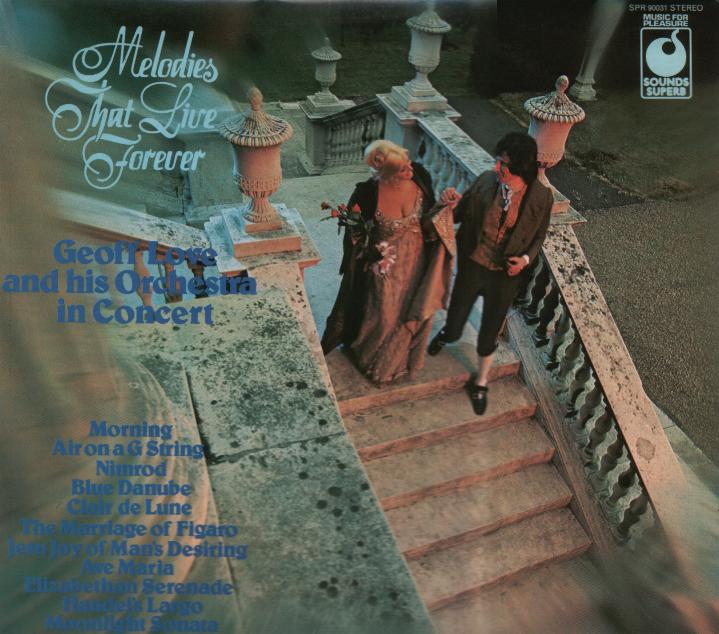


TRACK LISTING
SIDE ONE
1. Overture: The Marriage of Figaro
(Mozart)
2. Enigma Variations No.
9 Nimrod (Op. 36) (Elgar)
3. Air on a 'G' String
(Bach)
4. Clair de Lune
(Debussy)
Piano solo: Neil Rhoden
5. Jesu, Joy of Man's
Desiring
From Cantata No. 147 (Bach)
Oboe solo: Judith Thomas
6. Ave Maria
(Bach/Gounod)
SIDE TWO
1. Morning (Peer Gynt Suite No. 1 Op.
46) (Grieg)
2. Elizabethan Serenade
(Binge)
3. Largo (Handel)
4. Moonlight Sonata
(Beethoven)
Piano solo: Neil Rhoden
5. The Blue Danube (J. Strauss)
The concept of a hit-parade
of all-time classical favourites was inspired by the B.B.C. radio programme
"Your Hundred Best Tunes", and with this in mind Geoff Love has selected eleven
titles which feature in this top hundred. These he presents on this album with
his own distinctive style of arrangement to provide a permanent tribute to the
Melodies
That Live Forever.
Although the gay and scampering Marriage of Figaro Overture does not quote from
the music which follows, there could not
be a more appropriate introduction to the story of Count Almaviva's straying
affections or the wit of Mozart's music.
Each of Elgar's variations depicts one of the composer's friends. Nimrod was
August Johannes Jaeger, artistic
adviser to the composer's publishers.
Bach's Air on A 'G' String derives its name from the fact that August Wilhelmj,
the famous violinist, arranged it for playing on the lowest string of his
instrument. Originally it was a movement in the orchestral Suite in D major.
The deliciously atmospheric Clair de Lune is the third movement of Debussy's
Suite Bergamasque for solo piano.
Now familiar in many forms, Jesu, Joy of Alan's Desiring comes from a cantata in
which it is allotted to a four-part
chorus, with a lovely oboe obbligato.
Ave Maria is a transcription of the first prelude of Bach's 48 Preludes and
Fugues in which Gounod adapted the Bach original as an accompaniment to a melody
of his own. Grieg wrote his incidental music to Ibsen's drama Peer Gynt for a
performance in Christiana in 1875. Morning depicts sunrise as the wandering Peer
Gynt stands before the statue of Memnon in Morocco. The Elizabethan Serenade of
Binge may be twentieth century in style but is older in spirit.
Surprisingly enough Handel's Largo was not conceived as religious music. It is a
song in the opera Serse expressing gratitude for the cool shade provided by a
plane tree.
The Moonlight Sonata was not so called by Beethoven. An early critic called
Rellstab wrote that the first movement reminded him of moonlight on Lake
Lucerne, and the name stuck.
The Blue Danube was Strauss's contribution towards the raising of morale in
Vienna after the disastrous war with Prussia.
W. A. Chislett
Produced by Norman Newell
Assistant Producer Gil King
(P) 1975 A Supertunes Production
Also available on CD: